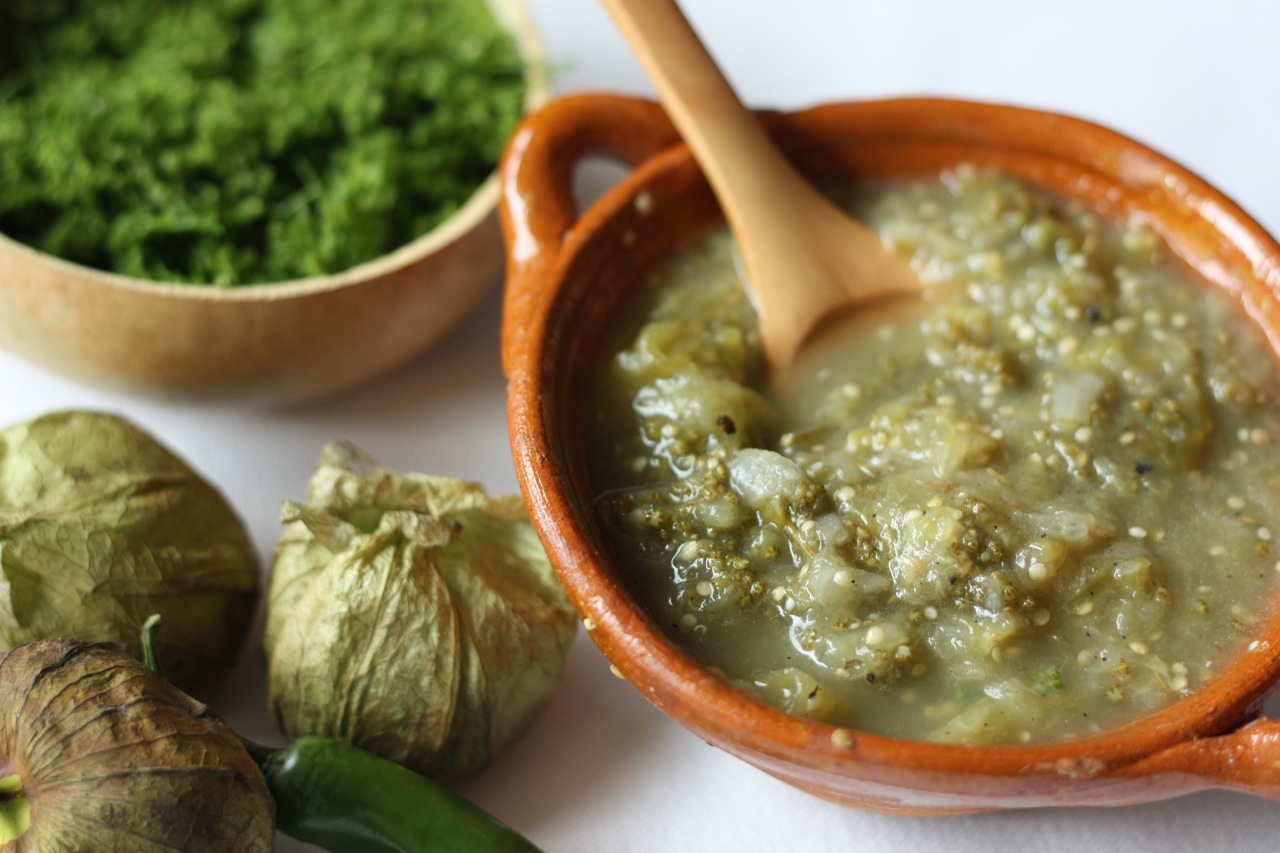Let me tell you a little about this chica. She grew up in Cali, studied in Mass and now resides in DF. She sounds cool already, no? Lesley is a journalist by  trade and after relocating to Mexico City, she has combined her love of writing with her love of cooking and eating. I don’t remember how I came to her blog, but I can tell you I knew I would be a regular just from the title The Mija Chronicles.
trade and after relocating to Mexico City, she has combined her love of writing with her love of cooking and eating. I don’t remember how I came to her blog, but I can tell you I knew I would be a regular just from the title The Mija Chronicles.
I’ll let you read about her here, but do navigate over to her blog. You will learn why I think the blog name is so cool and you’ll begin planning your next trip to Mexico City. Believe me, I am.
What is the elevator pitch for your blog?
The Mija Chronicles is a funny, honest look at my explorations with Mexican cuisine — cooking authentic Mexican dishes, learning traditional cooking techniques, and scrounging up enough confidence within myself to keep experimenting. It’s basically the tale of a Mexican-American woman living in Mexico, and learning the cuisine of her ancestors.
Why and when did you decide to become a blogger?
Gosh, sometimes I still don’t even think of myself as a blogger. I was a journalist for eight years working in newspapers in Texas, so most of me still thinks of myself that way. Before I started The Mija Chronicles, I’d done a bit of blogging before — I blogged about nightlife in my old job, I created a wedding blog when I got married in 2005, and I also briefly had a sewing blog that same year. The Mija Chronicles originally started as a way to keep our friends and family updated on our new adventure in Mexico City. (My husband and I moved here in January 2009.) But it quickly became obvious that I was mostly writing about food. After only a few months, I knew I wanted to throw myself into the cuisine and learn as much of it as I could. So my blog became an outlet for that.
What’s next for your blog?
I’d love to start doing instructional cooking videos. And I want to index my recipes so they’re easier for readers to find. I’d also like to start doing more Q&As with local chefs and other folks in the food world here in Mexico City, who I think are doing interesting things but aren’t getting much attention.
What is your favorite word?
Right now, one of my favorite words is “chatarra,” which means junk in Spanish. “Comida chatarra” is junk food.
FB or Twiter? Why?
Twitter. I love that you can have direct contact with such a wide variety of people. And I like the challenge of condensing my thoughts into 140 characters.
Michael or Prince?
Michael!
What’s your favorite one word insult to call someone?
I rarely insult anyone. Firm believer in getting more with honey than vinegar.
She’s groovy and girl gotz some serious kitchen skillz! I asked her to share something she considered absolutely Mexican, she gave us huauzontle. Check out this post for a complete run-down, but right here, that down there, that’s her tweaked salsa recipe. Yep. Uh huh. Check it.
Salsa de Tomate Verde (tomatillo salsa) with huazontles
by Lesley Téllez
It’s easy to find ready-made, fresh salsas in Mexico City. Lately, though, I’ve been a big fan of making them my own. And by that I mean grinding them from scratch in my molcajete.
It’s time consuming, but ultimately so satisfying. I choose each ingredient, and either toast it or boil it. Each item is individually placed into the molcajete, where I then smash it to smithereens. The salsa comes together because of my own strength and patience, not because I flipped a switch on a blender. And I really do mean strength and patience, by the way — you have to push through when you start sweating and your arm starts hurting. (I’m not sure if that just convinced you to make your own salsa from scratch, but I promise, it’s a unique experience.)
Huazuontles, pronounced wow-ZONE-tlays, are a bushy, fresh vegetable found practically year-round in Mexico City. They’re related to the amaranth family and only the soft buds are eaten. The thick stems and leaves are discarded because they’ve got a bitter, almost weed-like taste.
A typical tomatillo salsa has a well-balanced mix of acid and heat, and the huauzontles here don’t mess with that. They do add one key element, however: texture. The little flowery buds provide heartiness and an almost artichoke-broccoli-like chewiness. It’s like eating a really good, spicy pasta sauce.
I didn’t want this salsa’s flavor to be too raw and bright, so I kept a few pieces of tomatillo cáscara, and added roasted onion and garlic to mellow things out. An allspice berry, known in Spanish at pimienta gorda (literally, “fat peppercorn”) gave it just a whisper of spice, like that warmth you’d get from cumin or cinnamon.
It took about 45 minutes to grind this baby, but in the end it was worth it. I had a thick, lovely salsa that I served over lightly fried tortillas, sandwiched together with refried beans. I had only cooked this for myself, and it felt like a special treat.
Recipe below.
Salsa de tomate verde con huauzontles
(Tomatillo salsa with huazontles)
Makes about 1 1/2 cups
Note: What Americans think of as a tomatillo — a green tomato in a papery husk — has two names in Mexico, based on the fruit’s size. The tomate verde (literally, “green tomato”) is around the size of a plum (perhaps slightly larger than an apricot?) and very acidic. The tomatillo (lit., “little tomato”) is usually about the size of a large cherry. It tends to be sweeter. I used tomate verde because that’s what was available. I also refer to it as tomate verde in the recipe below, not tomatillo.
You’ll note that I only roasted my onion and garlic. Roasting the tomate verde makes it sweeter, and I didn’t want my salsa to be too sweet. You’re welcome to roast whatever you see fit. There’s no wrong way to do this salsa, unless you over-blend it and add too much water.
You can find the pimienta gorda at mercados and tianguis. In my cooking class, we used them pretty much every time we make a salsa molcajeteada.
Ingredients
12 ounces (350 grams) tomate verde, peeled and rinsed (see headnote)
2 serrano chiles
2.5-ounce piece of onion (72 grams), or just less than half of a medium onion
1 garlic clove, unpeeled
1 pimienta gorda (see headnote)
About 1/2 teaspoon coarse-ground sea salt
1/4 cup huauzontles, cleaned, boiled and drained
Directions
Place tomate verde and serrano chiles in saucepan, and pour just enough water over them to cover. Bring to a slow, rolling boil, and cook until both have turned a dull green color and softened, about 10 minutes. Drain and set aside.
While the tomatillos are cooking, roast the whole piece of onion and unpeeled garlic clove on a comal, or over a gas burner, until the skin is blackened in spots.
Remove to a cutting board and chop roughly. Or, if you’re a whiz on the molcajete, leave them whole.
Add your salt and pimienta gorda to the molcajete and grind until powdery. Add the garlic and grind into a paste. Then add the onion, and grind until the onion becomes slick and juicy, and you no longer see large pieces of onion in your molcajete.
Add the serranos and, using your tejolete, or pestle, break up the thin chile skins as best you can. Then add the tomatillos, one by one, making sure you tear apart their thick skins.
At this point, you can stir in the huauzontles and season with more salt, if needed. Or set it aside and reheat the salsa in a saucepan, in a bit of oil. The salsa is best served warm. It does tend to thicken as it cools, so feel free to add a bit more water to reach your desired consistency.
I want a big spoonfool of THAT! Ok bloggies. Take a moment to visit Lesley over at The Mija Chronicles and say ‘andale, andale, arriba, arriba!”.
Anamaris

Comments ( 3 )
You have given me a reason to use my molcajete instead of having it as another decoration for my kitchen. I know I have to cure it, but will do over the weekend. I am going over to her blog to join up...wonderful post.
I think Lesley is very talented! Great interview~ LOVE to hear about her adventures with Mexican food in MEXICO!
Thanks for featuring me Anamaris! It turned out great. :-)